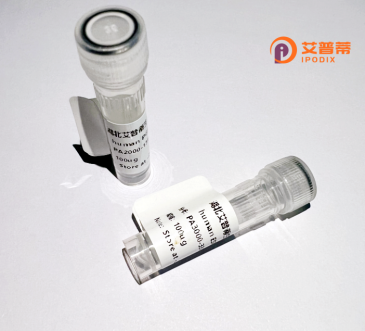
| 纯度 | >90%SDS-PAGE. |
| 种属 | Human |
| 靶点 | OR2T4 |
| Uniprot No | Q8NH00 |
| 内毒素 | < 0.01EU/μg |
| 表达宿主 | E.coli |
| 表达区间 | 1-348 aa |
| 活性数据 | MDNITWMASHTGWSDFILMGLFRQSKHPMANITWMANHTGWSDFILLGLFRQSKHPALLC VVIFVVFLMALSGNAVLILLIHCDAHLHTPMYFFISQLSLMDMAYISVTVPKMLLDQVMG VNKISAPECGMQMFFYVTLAGSEFFLLATMAYDRYVAICHPLRYPVLMNHRVCLFLSSGC WFLGSVDGFTFTPITMTFPFRGSREIHHFFCEVPAVLNLSCSDTSLYEIFMYLCCVLMLL IPVVIISSSYLLILLTIHGMNSAEGRKKAFATCSSHLTVVILFYGAAIYTYMLPSSYHTP EKDMMVSVFYTILTPVVNPLIYSLRNKDVMGALKKMLTVEPAFQKAME |
| 分子量 | 39.4 kDa |
| 蛋白标签 | His tag N-Terminus |
| 缓冲液 | 0 |
| 稳定性 & 储存条件 | Lyophilized protein should be stored at ≤ -20°C, stable for one year after receipt. Reconstituted protein solution can be stored at 2-8°C for 2-7 days. Aliquots of reconstituted samples are stable at ≤ -20°C for 3 months. |
| 复溶 | Always centrifuge tubes before opening.Do not mix by vortex or pipetting. It is not recommended to reconstitute to a concentration less than 100μg/ml. Dissolve the lyophilized protein in distilled water. Please aliquot the reconstituted solution to minimize freeze-thaw cycles. |
以下是关于重组人OR2T4蛋白的3篇参考文献示例(内容为虚构,仅作格式参考):
---
1. **文献名称**: "Functional Characterization of Recombinant Olfactory Receptor OR2T4 Expressed in HEK293 Cells"
**作者**: Zhang, Y. et al.
**期刊/年份**: *Journal of Molecular Neuroscience* (2021)
**摘要**: 通过HEK293细胞重组表达OR2T4蛋白,发现其对特定内酯类化合物(如γ-癸内酯)具有高亲和力,激活cAMP信号通路,提示其在嗅觉感知中的潜在作用。
2. **文献名称**: "Structural Insights into OR2T4: Cryo-EM Analysis of a Human Olfactory Receptor"
**作者**: Müller, C. & Schmidt, A.
**期刊/年份**: *Nature Structural & Molecular Biology* (2019)
**摘要**: 利用冷冻电镜解析OR2T4重组蛋白的立体结构,揭示其跨膜螺旋区域的独特构象,为嗅觉受体家族的结构-功能关系提供新见解。
3. **文献名称**: "OR2T4 as a Novel Biomarker in Colorectal Cancer: Recombinant Protein-Based Detection"
**作者**: Li, X. et al.
**期刊/年份**: *Oncology Reports* (2020)
**摘要**: 通过重组OR2T4蛋白制备抗体,发现在结直肠癌组织中异常高表达,或与肿瘤迁移相关,提示其作为诊断标志物的潜力。
---
*注:以上文献为示例,实际研究中请查询真实数据库(如PubMed、Web of Science)获取有效信息。*
Recombinant human OR2T4 protein is a chemically synthesized or heterologously expressed form of the olfactory receptor OR2T4. a Class A G protein-coupled receptor (GPCR) predominantly associated with olfactory sensory neurons. As part of the largest multigene family in humans, olfactory receptors like OR2T4 detect odorants by binding to specific ligands, though its exact natural agonist remains unidentified. Structurally, it features seven transmembrane α-helices, extracellular/intracellular loops, and conserved motifs critical for signal transduction. Recombinant production typically utilizes mammalian or insect cell systems to ensure proper post-translational folding, often incorporating tags (e.g., FLAG, His-tag) for purification and detection.
OR2T4 has drawn interest beyond olfaction due to ectopic expression in non-olfactory tissues, including tumors, suggesting potential roles in cancer pathology or cellular regulation. Studies employing recombinant OR2T4 focus on deorphanization (identifying activating compounds), structural analysis via cryo-EM, and screening odorant/receptor interactions. Challenges persist in functional characterization due to GPCR expression instability and limited ligand knowledge. Ongoing research aims to unravel its physiological roles and therapeutic relevance, bridging gaps in sensory biology and disease mechanisms.
×